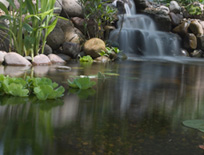pond
Oddly enough, this story takes place in a down economy and shows how, despite perceived financial limitations, something surprising and wonderful can happen when people put their minds to it. For years now, my work at Aquascape (St. Charles, Ill.) has largely focused on developing, designing and installing systems that in one or more ways are environmentally sound and beneficial. In early 2009, I began working on a plan for a prototype community designed around optimal use of its resources, especially water. I imagined a town filled with rainwater-capturing systems, permeable surfaces and efficient irrigation. It included nothing but indigenous plants, was organized with minimal turf areas and set aside space for composting and cooperative organic farming. As for the homes, all of them boasted various resource- and energy-efficient features. The overall concept was so
Readers Throw Cold Water on WSJ Pool Article As if the tanked economy wasn't bad enough for watershapers, The Wall Street Journal recently published an article ("Taking a Bath on Your Pool") that, essentially, calls into question the sanity of any homeowner who
In this series of occasional newsletter articles, the staff at Aquascape — a waterfeature design and installation company headquartered in St. Charles, Ill. — will offer information, advice and tips on creating and maintaining quality ponds, streams, waterfalls and pondless waterfeatures. Along the way, the coverage will range from the very basic — the sort of information you can use in training new staff and helping your clients — to the very advanced. To get things started, here's
Last month, we began our discussion of a large pond, stream and waterfall system for a historic upper Midwest estate found on the forested shore of a scenic lake. As related there, the project was to include three major ponds and a series of complex waterfall structures connected by streams rising close to the top of the gently sloping property. To sum up, the space we were working with measured approximately 300 feet wide and 800 feet long – a large section of a 35-acre estate marked by scores of mature trees that largely governed the watershapes’ configurations. Moreover, as there were no natural rock formations or outcroppings on site, we faced the need to
Where do rivers start? That’s a question that has always fascinated me, basically because I know that the Nile, the Amazon and the Thames – as majestic and life-giving as they and many of the world’s other great rivers become – all begin as mere trickles. Indeed, with the notable exception of rivers that erupt from the ground as powerful streams, most great rivers start out as subtle emanations of water that has migrated, globule by globule, through vast areas of porous rock to emerge as tiny rivulets in zones known as “spring lines.” These spaces typically exist between
For a long time, we’ve focused on creating highly naturalistic ponds, cascades and streams that fit seamlessly into the wooded landscapes of North Carolina – projects of such quality that they stand up well in comparison to the vast numbers of natural watershapes we see just about every time we turn around. Until recently, the overwhelming majority of these watershapes were installed in backyards, away from public view, with many of them situated on these properties in ways that removed them from immediate access or turned them into remote destinations. That preference among our clients at Xstream Ponds (Cashiers, N.C.) seems to be changing. In the past few years, in fact, we’ve noticed a
As a rule, those of us who build watershapes meant for purposes other than swimming or hydrotherapy tend to pursue one path or another: Either we make our ponds, streams and waterfalls look as natural as we can manage, or we establish them to reveal the hand of man either partly or completely. In that either/or context, successful design depends at least in part on being perfectly clear with ourselves about what we are trying to achieve. In assessing ponds of these opposing forms, it's my personal practice to look at both natural ponds and formal ponds (or, more accurately, architectural ponds) as being right on par with one another with respect to their potential for beauty. Indeed, architectural ponds can be incredibly appealing when done up in such a way that
As a rule, those of us who build watershapes meant for purposes other than swimming or hydrotherapy tend to pursue one path or another: Either we make our ponds, streams and waterfalls look as natural as we can manage, or we establish them to reveal the hand of man either partly or completely. In that either/or context, successful design depends at least in part on being perfectly clear with ourselves about what we are trying to achieve. In assessing ponds of these opposing forms, it's my personal practice to look at both natural ponds and formal ponds (or, more accurately, architectural ponds) as being right on par with one another with respect to their potential for beauty. Indeed, architectural ponds can be incredibly appealing when done up in such a way that




















